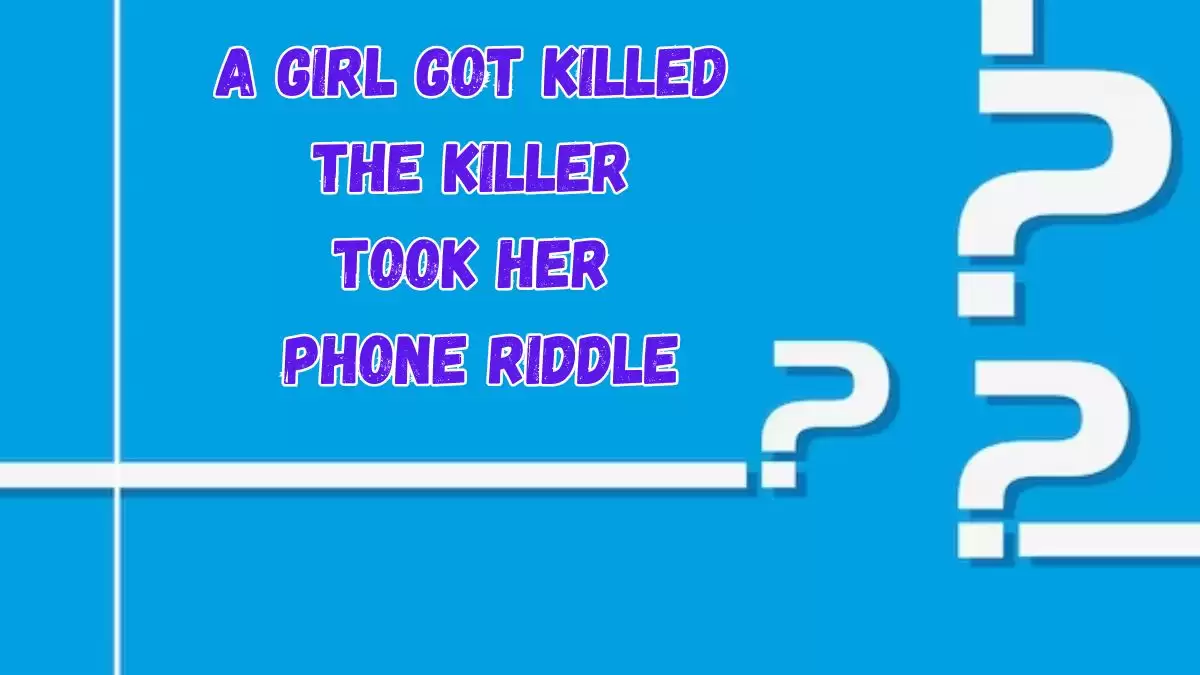A Girl Got Killed the Killer Took Her Phone Riddle Answer Solved
by Priyanka P
Updated Nov 15, 2023

A Girl Got Killed the Killer Took Her Phone Riddle
In this puzzling scenario, a girl meets a tragic fate, and the mystery lies in what the killer chose to take. The riddle unfolds with a list of items, including her phone, providing a puzzle for those seeking to unravel the sequence of events.
The challenge here is to discern the significance of each element in the story. As readers ponder the possibilities, they're encouraged to think beyond the obvious and consider the layers of meaning embedded in the narrative. This riddle taps into the human tendency to associate significance with tangible possessions, prompting a mental exercise in deductive reasoning.
The solution requires a careful examination of the clues presented and an ability to sift through the distractions. It's a clever play on expectations, inviting participants to engage in a mental game that transcends the mere collection of details.
Stay informed and up-to-date with the latest news and developments by turning to Fresherslive’s current news articles. Our platform is designed to help you broaden your horizons and gain valuable insights.
A Girl Got Killed the Killer Took Her Phone Riddle Explained
In this enigmatic riddle, the solution lies in the grim outcome: the girl's life is taken by the killer. The narrative deliberately introduces a list of items, such as her phone, to divert attention and create a puzzle. However, the key to solving the riddle is recognizing that the killer's primary action was ending the girl's life.
The inclusion of possessions like the phone serves as a red herring, leading participants to consider alternative interpretations. It's a clever play on expectations, emphasizing the importance of looking beyond the obvious. The challenge lies in navigating through the distractions to unveil the real, albeit somber, answer: the killer took the girl's life.
This riddle showcases the intricacy of language and the art of misdirection, engaging participants in a mental exercise that transcends the surface narrative.
What is a Riddle?
A riddle is a type of puzzle or word game that presents a mystery or question in a clever and often cryptic way. It typically involves a statement, question, or phrase with a hidden or double meaning, challenging the person to figure it out. Riddles come in various forms, such as enigmas, which require creative thinking and metaphorical interpretation, and conundra, which rely on wordplay or puns in the question or answer.
Riddles have been part of human culture for centuries and can be found in many different cultures worldwide. They are like brain teasers, designed to engage the mind and encourage problem-solving. People enjoy riddles for the mental challenge and the satisfaction of unraveling the hidden meaning. Riddles often serve as a form of entertainment and intellectual exercise, and they can be a fun way to test and expand one's thinking abilities.
Advantages of Solving Riddle
Solving riddles offers several advantages, making it an enjoyable and beneficial activity:
Mental Stimulation:
Riddles require critical thinking, creativity, and problem-solving skills. When you solve a riddle, you exercise your brain, keeping it active and sharp.
Enhanced Problem-Solving Skills:
Riddles often present complex challenges in a concise format. Solving them hones your ability to analyze information, think logically, and find innovative solutions.
Improved Language Skills:
Riddles play with words, encouraging better vocabulary, wordplay, and linguistic comprehension. They can be an enjoyable way to learn new words and phrases.
Boosted Confidence:
Successfully solving a challenging riddle can be incredibly satisfying, leading to increased self-confidence and a sense of accomplishment.
Entertainment:
Riddles are a source of entertainment and amusement, whether solved individually or as part of a group. They can be a fun way to pass the time.
Social Interaction:
Riddles often prompt discussions and interactions among people trying to solve them together, fostering teamwork and communication.
Cultural Understanding:
Riddles are found in many cultures, and solving riddles from different parts of the world can offer insights into diverse perspectives and traditions.
Creativity:
Riddles encourage thinking "outside the box" and inspire creative solutions to problems.
A Girl Got Killed the Killer Took Her Phone Riddle - FAQs
The riddle presents a mystery where a girl is killed, and the answer lies in the unexpected item the killer took, diverting attention from the apparent clues.
The inclusion of items like iPhone and AirPods is a deliberate attempt to mislead, prompting readers to consider tangible possessions instead of the actual answer, which is more abstract.
The riddle gained popularity during the national lockdown, showcasing the enduring appeal of puzzles and mental challenges as a means of entertainment and engagement.
The riddle revolves around misdirection and the complexity of language, highlighting the importance of looking beyond apparent details to uncover the genuine solution.
The riddle cleverly plays on expectations by introducing seemingly relevant items like an iPhone, leading participants to consider alternative interpretations before arriving at the unexpected answer: the girl's life.







